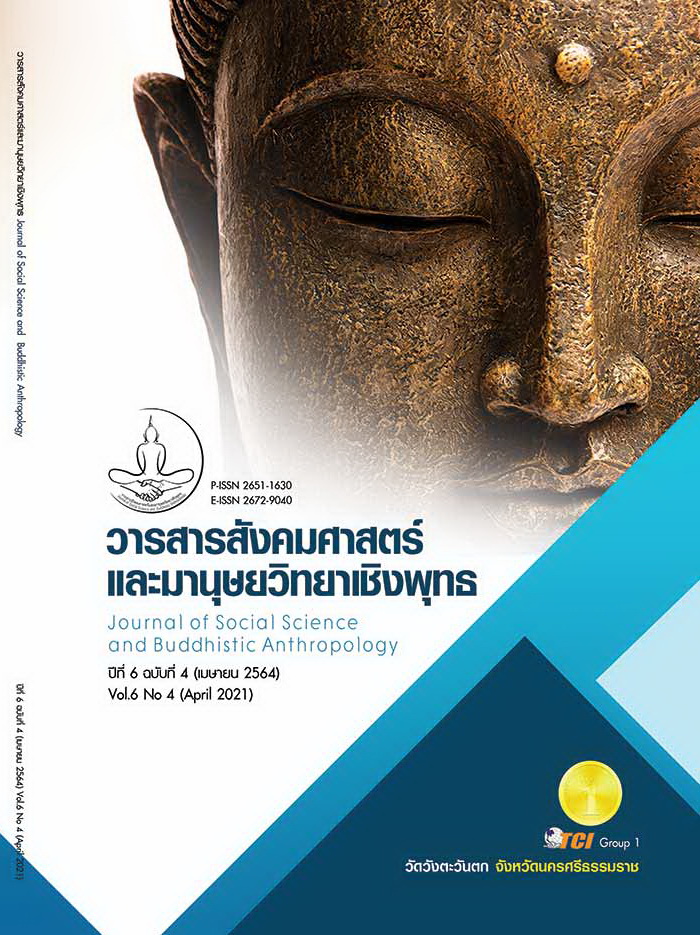COOKING TERMS IN THAI COOKBOOK: AN ANALYSIS OF LADY SOMCHIN RACHANUPRAPHAN’S TAMRA KAPKHAO
Keywords:
Cooking Terms, Thai Cookbooks, Lady Somchin RachanupraphanAbstract
The objectives of this article were to study cooking terms which were used in a cookbook called “Tamra Kapkhao.” This cookbook was composed by Lady Somchin Rachanupraphan (Bunnag) and it was firstly published in Rattanakosin Era 109 (B.E. 2433). The cookbook was acknowledged as the first Thai cookbook. Results of the study revealed that the cooking terms utilized in the “Tamra Kapkhao” could be classified into four types including types of food, kitchen tools and utensils, cooking ingredients, and cooking methods. These four types of the cooking terms as realized through Lady Somchin Rachanupraphan’s cookbook also reflected various aspects of Thai culture. Especially, Thai people’s ways of food consumption. This shall be traced that the Thai food consumption in the Rama 5th era and the present time are similar in various aspects. However, there were some changes occurred. To exemplify, some ingredients were commonly used in cooking in the past but such ingredients are not frequently used in the present. For example, animals such as soft-shelled turtles, bamboo rats, and ground lizards. Moreover, the “Tamra Kapkhao” also echoed that Thai people possess various cooking and food comsuption wisdoms such as enhancing tastes, flavoring, and making use of herbs. Thai people have given importance to timing for cooking each dish as well as pay attention to plating and arranging a meal tray. Thus they could design good mixing and perfect matching of ingredients or types of food for making a better combination. This mixing and matching wisdom is reckoned both to a given dish and arranging different types of food in a serving tray. In addition, Thailand has been contacted with foreigners, as a result, exchange and acculturation of food have occurred. Some foreign dish have been adopted and adjusted to be Thai dish as well.
References
จุฑารัตน์ นามวงษ์ และภาสพงศ์ ผิวพอใช้. (2562). คำกริยาการีตเกี่ยวกับการประกอบอาหาร: ศึกษาจากตำรากับเข้าของหม่อมซ่มจีน ราชานุประพันธ์. ใน เอกสารสืบเนื่องจากการประชุมวิชาการและนำเสนอผลงานวิจัยระดับชาติและนานาชาติ ด้านมนุษยศาสตร์และสังคมศาสตร์ ครั้งที่ 10 (หน้า 803-814) วันที่ 29 มีนาคม 2562 ณ อาคารศรีจุฑาภา. มหาวิทยาลัยราชภัฏสวนสุนันทา.
เปรม สวนสมุทร. (2560). ตำรับชาววัง : นวัตกรรมแห่งโภชณียประณีต Tam Rap Chao Wang : Innovation of the Food Refinement. วารสารวิชาการนวัตกรรมสื่อสารสังคม, 5(2), 153-164.
ภาสพงศ์ ผิวพอใช้. (2560). การศึกษาคำแสดงโภชนลักษณ์ในตำราอาหารไทย : ศึกษาจากตำราแม่ครัวหัวป่าก์ของท่านผู้หญิงเปลี่ยน ภาสกรวงศ์. วารสารศิลปศาสตร์, 13(2), 138-165.
ภาสพงศ์ ผิวพอใช้. (2563). รายงานการวิจัยเรื่องคำแสดงโภชนลักษณ์ในอาหารไทยและลาว: การศึกษาเปรียบเทียบ สำนักงานส่งเสริมบริหารงานวิจัย บริการวิชาการและทำนุบำรุงศิลปวัฒนธรรม. อุบลราชธานี: มหาวิทยาลัยอุบลราชธานี.
ราชบัณฑิตยสถาน. (2556). พจนานกรม ฉบับราชบัณฑิตยสถาน พ.ศ. 2554 เฉลิมพระเกียรติพระบาทสมเด็จพระเจ้าอยู่หัว เนื่องในโอกาสพระราชพิธีมหามงคลเฉลิมพระชนมพรรษา 7 รอบ 5 ธันวาคม 2554. กรุงเทพมหานคร: ราชบัณฑิตยสถาน.
สุนันท์ อัญชลีนุกูล. (2550). คำแสดงโภชนลักษณ์ในตำราอาหารของ ม.ล. เติบ ชุมสาย และในตำราอาหารเว็บไซต์ปลาแดกดอทคอม. ใน รวมบทความวิจัย ยำใหญ่ใส่สารพัด: วัฒนธรรมอาหารไทย-เทศ. คณะอักษรศาสตร์ จุฬาลงกรณ์มหาวิทยาลัย.
สุนันท์ อัญชลีนุกูล. (2551). หลากมิติคำแสดงโภชนลักษณ์ในตำราอาหารไทย อังกฤษ ฝรั่งเศส. วารสารอักษรศาสตร์, ฉบับพิเศษ(2551), 251-277.
หม่อมซ่มจีน ราชานุประพันธ์. (2433). ตำรากับเข้า. กรุงเทพมหานคร: โรงพิมพ์วัชรินทร์.
Hanuman, T. K. (2016). ตำรับ “ไก่ผะแนง” จากตำราอาหารที่เก่าสุดในสยาม. เรียกใช้เมื่อ 31 มิถุนายน 2561 จาก https://thaifoodmaster.com/thai_food_recipes-th/thai_curry_recipes-th/9304?lang=th#.X8ZPTM








